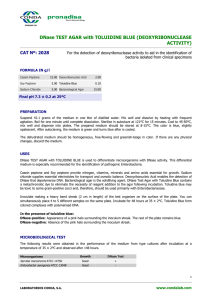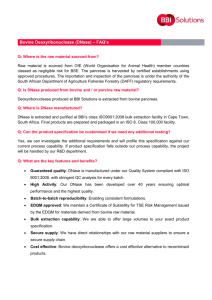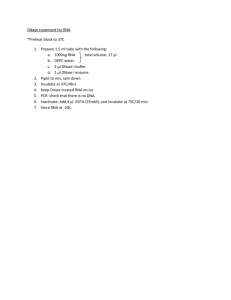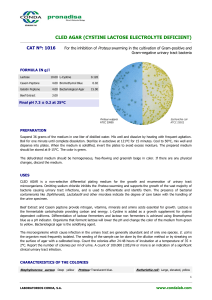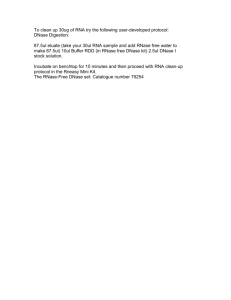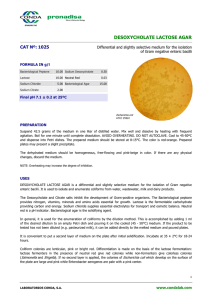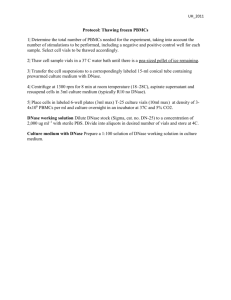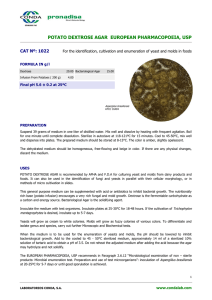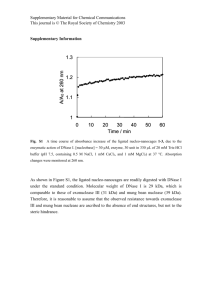DNase TEST AGAR (DEOXYRIBONUCLEASE ACTIVITY) CAT Nº: 1028
advertisement
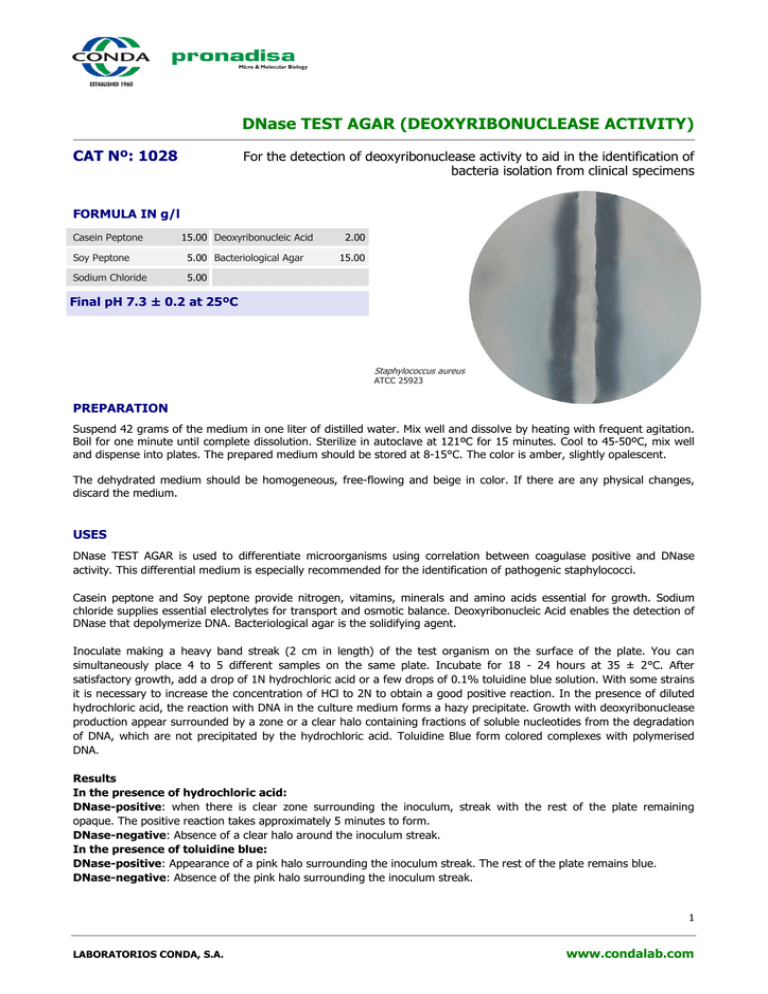
DNase TEST AGAR (DEOXYRIBONUCLEASE ACTIVITY) CAT Nº: 1028 For the detection of deoxyribonuclease activity to aid in the identification of bacteria isolation from clinical specimens FORMULA IN g/l Casein Peptone 15.00 Deoxyribonucleic Acid 2.00 Soy Peptone 5.00 Bacteriological Agar 15.00 Sodium Chloride 5.00 Final pH 7.3 ± 0.2 at 25ºC Staphylococcus aureus ATCC 25923 PREPARATION Suspend 42 grams of the medium in one liter of distilled water. Mix well and dissolve by heating with frequent agitation. Boil for one minute until complete dissolution. Sterilize in autoclave at 121ºC for 15 minutes. Cool to 45-50ºC, mix well and dispense into plates. The prepared medium should be stored at 8-15°C. The color is amber, slightly opalescent. The dehydrated medium should be homogeneous, free-flowing and beige in color. If there are any physical changes, discard the medium. USES DNase TEST AGAR is used to differentiate microorganisms using correlation between coagulase positive and DNase activity. This differential medium is especially recommended for the identification of pathogenic staphylococci. Casein peptone and Soy peptone provide nitrogen, vitamins, minerals and amino acids essential for growth. Sodium chloride supplies essential electrolytes for transport and osmotic balance. Deoxyribonucleic Acid enables the detection of DNase that depolymerize DNA. Bacteriological agar is the solidifying agent. Inoculate making a heavy band streak (2 cm in length) of the test organism on the surface of the plate. You can simultaneously place 4 to 5 different samples on the same plate. Incubate for 18 - 24 hours at 35 ± 2°C. After satisfactory growth, add a drop of 1N hydrochloric acid or a few drops of 0.1% toluidine blue solution. With some strains it is necessary to increase the concentration of HCl to 2N to obtain a good positive reaction. In the presence of diluted hydrochloric acid, the reaction with DNA in the culture medium forms a hazy precipitate. Growth with deoxyribonuclease production appear surrounded by a zone or a clear halo containing fractions of soluble nucleotides from the degradation of DNA, which are not precipitated by the hydrochloric acid. Toluidine Blue form colored complexes with polymerised DNA. Results In the presence of hydrochloric acid: DNase-positive: when there is clear zone surrounding the inoculum, streak with the rest of the plate remaining opaque. The positive reaction takes approximately 5 minutes to form. DNase-negative: Absence of a clear halo around the inoculum streak. In the presence of toluidine blue: DNase-positive: Appearance of a pink halo surrounding the inoculum streak. The rest of the plate remains blue. DNase-negative: Absence of the pink halo surrounding the inoculum streak. 1 LABORATORIOS CONDA, S.A. www.condalab.com Nevertheless, for some fastidious organisms it may be necessary to add blood. The addition of diluted hydrochloric acid forms a well defined but opaque halo with DNase-positive organisms. The DNase medium with blood should not be used in the study of hemolytic reactions and should only be added if absolutely necessary. MICROBIOLOGICAL TEST The following results were obtained in the performance of the medium from type cultures after incubation at a temperature of 35 ± 2ºC and observed after 18-24 hours. Microorganisms Staphylococcus epidermidis ATCC 12228 Staphylococcus aureus ATCC 6538 Staphylococcus aureus ATCC 25923 Serratia marcescens ATCC 8100 Growth DNase Test Transparency Good Good Good Good + + + BIBLIOGRAPHY Blair E.B. Emerson, J.S. and Tull, S.C. Am. J.Clin.Poth, 47:30-39, 1957. Disalvo Med. Tech. Bull. 9:191. 1958. Weckman and Catting J. Bact. 73: 747. 1957. STORAGE 25ºC Once opened keep powdered medium closed to avoid hydration. 2ºC 2 LABORATORIOS CONDA, S.A. www.condalab.com
